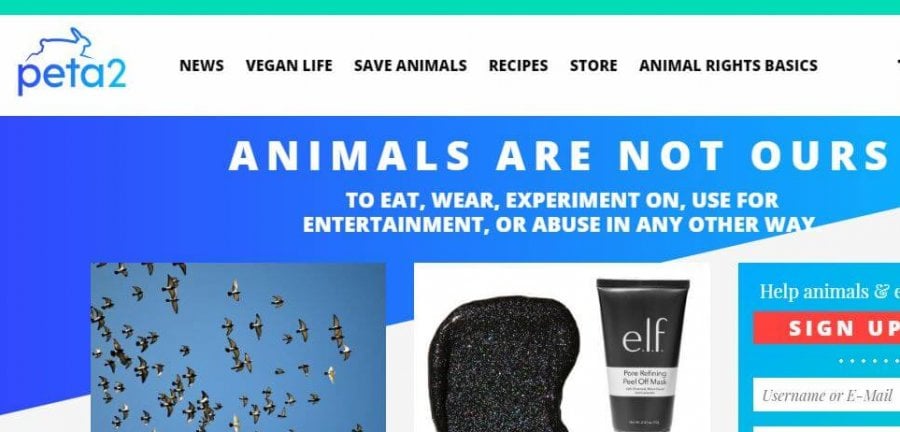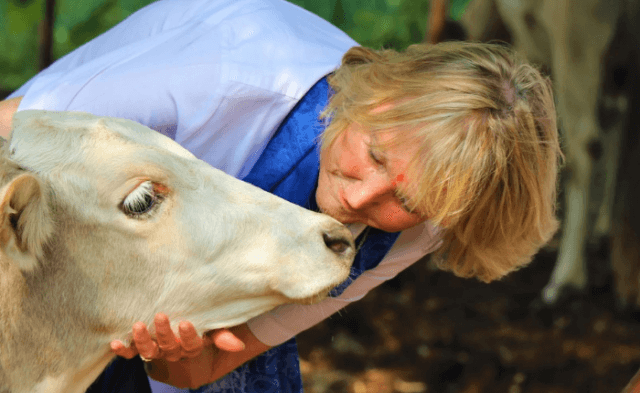What’s the difference between PETA and peta2? The campaign goals are the same, but the difference is the target audience. We created peta2 to inject the concept of animal rights directly into the bloodstream of today’s youth culture.
That’s because the best way to create lasting, long-term changes for animals is by making sure that future generations understand that animals have the right not to be turned into a burger or a belt or to be tested on.
Our objective is to make it impossible for young people to graduate high school or college without knowing that animal rights is a serious social issue that deserves their attention.
peta2 puts a youth-friendly spin on all of PETA’s campaigns by making them a little more edgy while emphasizing the use of social-media platforms that we know young people use. For example, PETA was one of the very first nonprofits to figure out how to use Twitter as a tool for activism.
Young people who join peta2’s Street Team receive weekly activist “missions”—fun, innovative, and quick actions that they can take to promote animal rights in their community. Street Teamers accumulate points for completing these missions, which they can cash in for PETA T-shirts, celebrity-autographed items, and other prizes.
With more than 560,000 young people actively engaging with peta2, PETA has the largest youth membership not just of any animal group but of any social-justice organization, period.
Mastering the Art of Outreach
Every summer, peta2 dominates the summer music scene by hitting the road with some of the most popular concert tours. We set up booths at each concert so that every day, thousands of young people can take our literature and DVDs and watch videos of undercover investigations.
Every day that we’re on tour, we recruit thousands of new peta2 members who sign campaign petitions and subscribe to our action alert texting program, through which they can take action on important issues instantly.
We also offer young people a visceral, hands-on experience through our wildly innovative, interactive exhibits. One of our recent campaigns inspired more than 80,000 people to take the “Try Vegan” pledge via their mobile phones and to subscribe to our text message tips on eating vegan. This exhibit, which accompanied last summer’s massively popular Vans Warped Tour, was designed to resemble a carnival sideshow tent. Inside, interactive and cheeky displays and games encouraged visitors to consider that our present society’s treatment of animals is often just as antiquated and bizarre as the “human oddity” sideshows of the past.
On the college front, we’re making a huge impact. Our “Glass Walls” exhibit—the largest and most visually arresting animal rights exhibit ever to travel to campuses—appeared at more than 60 colleges and universities last year. The attention-grabbing walk-through display—featuring a life-size gestation crate and compelling footage of how chickens, turkeys, pigs, and cows suffer before they’re killed for the table—sparked enormous interest from students coast to coast.
As a result of peta2’s efforts working alongside students who are pushing for more vegan options on campus, dozens of universities have expanded the cruelty-free offerings on their menus, including Ohio State University, the University of Colorado, the University of Central Florida, the University of California–Irvine, and the University of California–San Diego, which opened its first all-vegan dining hall.
To capitalize on some young people’s obsession with video games, we also create games with a strong animal rights message that are spread widely online. For instance, on the day PETA launched a Pokémon parody game, we received more than 1 million hits on our website. Our hard-hitting “Free Me” video (which takes viewers on a heartbreaking journey through the horrors of using animals for food, clothing, experimentation, and entertainment) automatically plays at the end of the game and has now been viewed more than 510,000 times.
We’re confident that not a day goes by that a young person somewhere doesn’t have a life-changing revelation as a result of peta2’s work. Augustus Club members, and all PETA members, play a vital role in making this work possible. To learn more about becoming a PETA member, visit PETA.org. Thank you so much!
Stay tuned for our interview with Marta Holmberg, PETA’s Director of Youth Outreach and Campaigns.
This article was originally published in PETA’s Augustus Club newsletter. PETA’s Augustus Club is a complimentary club honoring those who are leaving a legacy for animals through a planned gift to PETA. If you have made a planned gift to PETA, please let us know so that we can thank you! If you have not yet left a legacy for animals but would like information on how to do so, please contact us.





